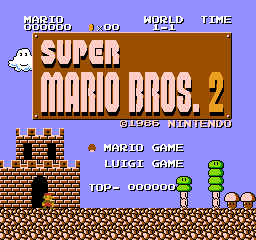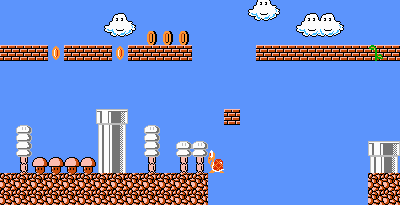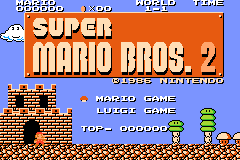If you appreciate the work done within the wiki, please consider supporting The Cutting Room Floor on Patreon. Thanks for all your support!
Super Mario Bros. 2 (Famicom Disk System)
| Super Mario Bros. 2 |
|---|
|
Also known as: Super Mario Bros.: The Lost Levels (INT), Super Mario Bros. 2: For Super Players (Super Mario Collection title screen)
|
The Japanese Super Mario Bros. 2 is basically the first Super Mario Bros. game, but with the difficulty cranked to 11. The expanded space provided by the disk format allowed for upgraded graphics, longer and more complex levels, several new gimmicks, and 5 new worlds (for a total of 13 worlds)... but overall, its graphics and music don't do it favors in distinguishing it from its predecessor.
That, factored in with its extreme difficulty, gave Nintendo of America cold feet, so they opted to have another FDS game modified to present a completely different Super Mario Bros. 2 to other regions. Overseas players first discovered this game through Super Mario All-Stars, albeit in a remade form. An unlockable version was also included with Super Mario Bros. Deluxe, although it did not have the unique graphics of the original release, unique abilities for Mario and Luigi, or anything normally accessible past World 8-4.
Overseas players did not get a chance to play the original, completely unaltered game until it was released internationally on the Wii Virtual Console, and it has since been brought over to the Wii U, 3DS, and the Nintendo Switch's online service. In most of these overseas re-releases, the game is referred to as Super Mario Bros.: The Lost Levels, though the title screen is left unchanged in said unaltered ports.
Sub-Pages
| Prerelease Info |
| Bugs |
Unused Variable
As with the previous game, RAM address 03F0 keeps track of the number of blocks hit, though no routine ever reads the value stored here.
Unused Graphics
Two unused ground tiles and a cactus can be found at the very end of the SM2CHAR1 graphics file. The last tile, a more natural-looking variation of the original Super Mario Bros. ground tile, actually appears in every screenshot in this game's manual, suggesting that it was changed very late in development.
Misplaced Enemy
In World 3-1, a Red Koopa Troopa is placed directly above a pit. It's normally impossible to see this enemy in-game, as by the time the player reaches the screen in question it's already fallen into the pit. The only way to see it without hacks is to glitch Mario's position to the furthest right side of the screen, then take damage, which causes the screen to scroll to the right and give the player a glimpse of the Koopa as it falls into oblivion.
Revisional Differences
In 2004, Super Mario Bros. 2 was re-released as part of Japan's Famicom Mini series for the Game Boy Advance as "Famicom Mini Vol. 21". The most significant change in this version is that pressing A + Start allows you to, after getting a Game Over, immediately go back to the start of the world where you lost all your lives in (barring Worlds 9 and A-D), just like in Super Mario Bros.. This not only renders the "Continue" option redundant, but has some other effects:
- Using the emulator's menu (accessible by pressing L + R) to save your high score will also save the last world you died on, meaning the A + Start combo still works even after the game is turned off, which makes it possible to complete the game in multiple sessions.
- It is possible to switch between Mario and Luigi mid-game without having to start over, which was not possible in the FDS version.
- After beating 8-4 eight times, the player must press B + Start at the title screen to access World A-1 rather than the FDS version's A + Start.
None of these changes were carried over to the Virtual Console and Switch releases, as they behave the same way as the original FDS version.
- Pages missing developer references
- Games developed by Nintendo
- Pages missing publisher references
- Games published by Nintendo
- Famicom Disk System games
- Pages missing date references
- Games released in 1986
- Games released in June
- Games released on June 3
- Games with unused code
- Games with unused graphics
- Games with revisional differences
- Mario series
Cleanup > Pages missing date references
Cleanup > Pages missing developer references
Cleanup > Pages missing publisher references
Games > Games by content > Games with revisional differences
Games > Games by content > Games with unused code
Games > Games by content > Games with unused graphics
Games > Games by developer > Games developed by Nintendo
Games > Games by platform
Games > Games by publisher > Games published by Nintendo
Games > Games by release date > Games released in 1986
Games > Games by release date > Games released in June
Games > Games by release date > Games released in June > Games released on June 3
Games > Games by series > Mario series
The Cutting Room Floor > Unimportant Awards > NES games > Famicom Disk System games


